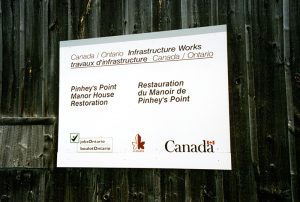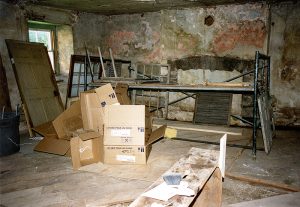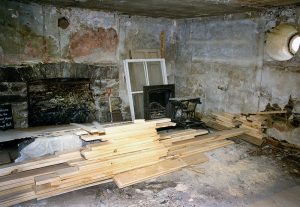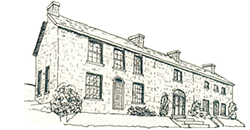The City of Kanata (now part of the City of Ottawa) assumed ownership of the Pinhey property in 1990 and commissioned renowned conservation architect Julian Smith to prepare a Master Plan Study to improve the old house. In 1993 Smith presented Kanata with several options: period restoration, rehabilitation—modification for contemporary uses, and minimal intervention. The City opted for a compromise: to alter the building as little as possible, but to upgrade it for contemporary functions in a way that reflects its original appearance. This work protects the house from further wintertime deterioration and makes it occasionally usable out of season.
Phase I and II
Assisted by funding from the federal/provincial Infrastructure Program, the long-awaited restoration of the Hamnett Pinhey mansion began in January 1995.

The first two phases included the installation of furnaces, heating ducts, air conditioning, electrical outlets, and plumbing.
Five propane furnaces were installed, one in each of the attics and one in the basement of each of the side wings. With the heating system in place the cellar was drier than it had been in many a year. Visitors long familiar with the property may recall the veritable torrents of water that flowed down the slope of the hill, through the cellar and out again, especially in spring. The cedar log floor beams no longer dripped condensation.

The new electrical outlets, including brass floor outlets, provided greater flexibility in lighting displays in the house.
The mid-20th century washroom that had intruded into the upstairs dining room from the landing at the head of the main staircase was removed.
Three new washrooms were added: two in the southeastern cross passage on the ground floor to the left of the stairs, and one, a staff washroom, in the front half of the first bedroom in the east wing.
New discoveries in the kitchen were most exciting to the historically minded. Previously blocked up, the great stone fireplace was opened and restored. The 1920s v-groove woodwork was stripped away, as was some of the lathed ceiling, to reveal the hand-hewn ceiling beams. Markings on the floor, and the only partial covering of the ceiling with lath-work, revealed that the two exterior doors that open into either side of the kitchen wing originally opened into a cross passage, and that two doors formerly gave ingress into the kitchen from this passage. Given the severity of Ottawa winters this arrangement was eminently sensible, but previously undocumented. This passage was restored.


The rear half of the kitchen rests upon bedrock. Some of the original flooring, laid parallel with the side walls, remains in the front half of the kitchen and former passage. However, much of this flooring had long ago been replaced with floorboards that ran diagonally throughout the room.
The cornice in the drawing room was of very recent vintage, installed to replace the original plasterwork which was fracturing and falling away. This was replaced to match the mouldings in adjoining rooms.
The open stair at the end of the second-floor sitting room above the ballroom (parlour) was enclosed with a fire wall to meet fire code, although the railing has been retained within the staircase. The new door replicates the originals elsewhere in the room, but the moldings have been simplified so that it character as a reproduction would be obvious on close inspection.

Phase III of the restoration of Horaceville began in January 1996. Included in this stage of the project were non-structural repairs, plastering, painting, lighting, and installing picture rails. Installation of the picture rails, requested by the Pinhey’s Point Foundation, facilitates displays in the parlour (ballroom), the dining room, and the room over the front entrance. Some external work, such as improving the flashing on the crest of the roof, was also completed.
Architect Larry Gaines of Julian Smith and Associates carefully selected the internal finishes by comparing the paints available from heritage supply companies with Deborah Hossack’s study of the historic finishes in the Pinhey house, commissioned some years ago by the Foundation. Attention to authenticity and detail is a hallmark of the work that has given Julian Smith and Associates a deserved reputation as one of the most respected firms of restoration architects in Canada.
Also in this phase, the original windows and shutters were put back in place where possible. Interestingly, it was discovered that the shutters were interior, which are far more practical, rather than exterior. Interior shutters are still to be found flanking the windows in the landing at the top of the main stair, but the presence of door-length jalousies (sham shutters) attached to the wings of the house for purposes of symmetry, along with Pinhey’s diary references to jalousies and shutters, had given the misimpression that most of the shutters were outside.
